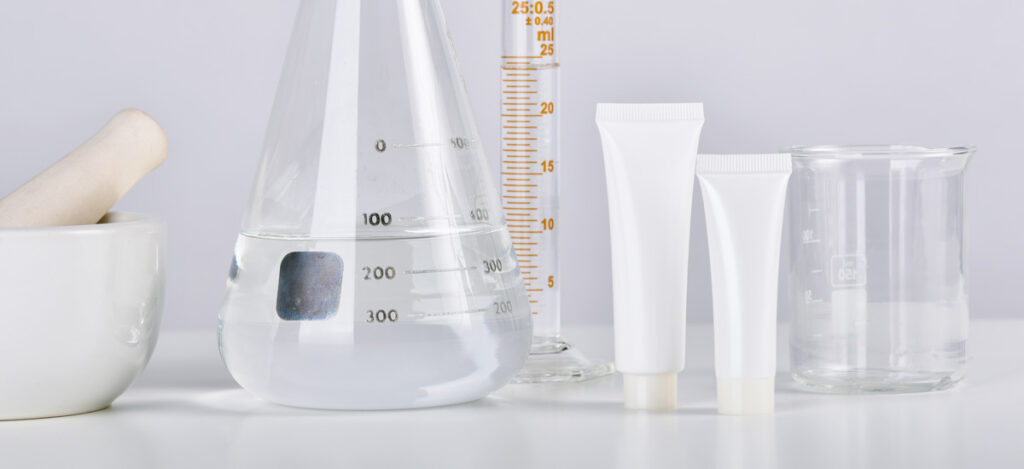What Are The Minimum Fill Requirements For Cosmetic Products?
What are cosmetic products (cosmetics)?
Cosmetics are products applied to the human body (normally on top of the skin) for cleaning and beautification purposes.
Examples of everyday cosmetics:
- Skin moisturizers
- Creams
- Facial makeups
- Shampoos
- Perfumes
- Toothpaste
Why are minimum fill requirements for cosmetics necessary?
Minimum fill tests ensure that the amount of material that ends up within a container is the amount on the product’s label. Minimum fills are determined primarily by mass and are used to fill creams, gels, lotions, ointments, pastes, powders, aerosols, foams, and sprays.
For Containers Labeled By Weight:
First, all labels are removed from filled products. Then the contents of the products are emptied fully. In some cases, a solvent is needed to completely remove viscous products such as creams, gels, and ointments. Next, emptied product containers are dried and weighed. The product’s net weight within each filled container is determined by the difference between the starting weight of the filled product and the weight of the product container once emptied.
For Containers Labeled By Volume:
All of the instructions for containers labeled by weight are used for containers labeled by volume. The difference is that after weights are obtained, the mass is converted to volume using the product’s density.

How to determine the product’s density for containers labeled by volume:
Add 25 milliliters (mL) of the product being assessed with 50 milliliters (mL) of a miscible liquid in a flask. The flask should be weighed with the miscible liquid before and after the 25 mL of the product are added. Once the product and miscible liquid have mixed, the mix is brought back to the original 75 mL volume.
The liquid volume needed to get the original volume back to 75 mL is recorded. Then the sample density is calculated with the equation below. Smaller vessels can be used for products under 25 mL.
Density = W/V
Where:
W = weight of the material in grams
V = 50.0 minus the volume, in mL, of the miscible fluid necessary to adjust the flask’s contents to 100 mL
For Aerosols, Sprays, & Foams:
All labels are removed from the product containers, and each filled product is weighed individually. The filled contents of each product are removed through a combination of chilling (to reduce compressed air pressure), valve removal, and pouring. Any residual content is removed with a suitable solvent. Next, the value, container, and extra container parts are heated to 100°C for five minutes, cooled, and weighed. Any difference between the original weight and the weight of the empty aerosol container is the net fill weight.
What are the minimum fill requirements (acceptance criteria) for cosmetic formulations?
One of two acceptance criteria must be met to pass minimum fill requirements. For the first criteria, the average of all product containers assessed (out of ten containers) must not be less than the amount printed on the label. Additionally, the net content of any container must not be less than 90% of the labeled amount for product quantities of 60 grams (or mL) or less. For products over 60 grams (or mL), not less than 95% of the labeled amount on the container must be present.
The second criteria are relevant if the first criteria are not reached. If the first criteria are not met, the product in twenty additional containers is assessed. The criteria mentioned above must be met for the thirty total containers assessed for fill weight. In other words, the net content of any container must not be less than 90% of the labeled amount for product quantities of 60 grams (or mL) or less. For products over 60 grams (or mL), not less than 95% of the labeled amount on the container must be present.
Summary
Overall, cosmetics are products applied to the human body (normally on top of the skin) for cleansing and beautification purposes. Minimum fill tests make sure that the amount of material that ends up within a container is the amount on the product’s label. Minimum fills are determined primarily by mass and are used to fill creams, gels, lotions, ointments, pastes, powders, aerosols, foams, and sprays. The minimum acceptance criteria for minimum fill volume must be not less than 90% or 95% of the labeled value. The 90% or 95% criteria depends upon the size of the product containers being filled. All in all, ensure you choose a contract manufacturing organization that can support you with your cosmetic product filling needs.
MycoScience is a contract manufacturing organization specializing in sterile syringe and vial filling cosmetic products or for products used in animal studies. In addition, MycoScience offers testing services, including Preservative Efficacy Testing, Cytotoxicity Testing, Bioburden Testing, Cleaning Validations, Microbial Aerosol Challenge Testing, Accelerated Aging, Microbiology Testing, EO Residual Testing, Bacterial Endotoxin Testing, Package Integrity Testing, Sterilization Validations & Environmental Monitoring services medical devices and allied industries. MycoScience is an ISO 13485 certified facility.
References
United States Food & Drug Administration. Cosmetics & U.S. Law. 2020.
United States Pharmacopeial Convention. <755> Minimum Fill. Rockville, MD, USA. 2021. (USPC <755>).
Sharing this in your social netwroks

